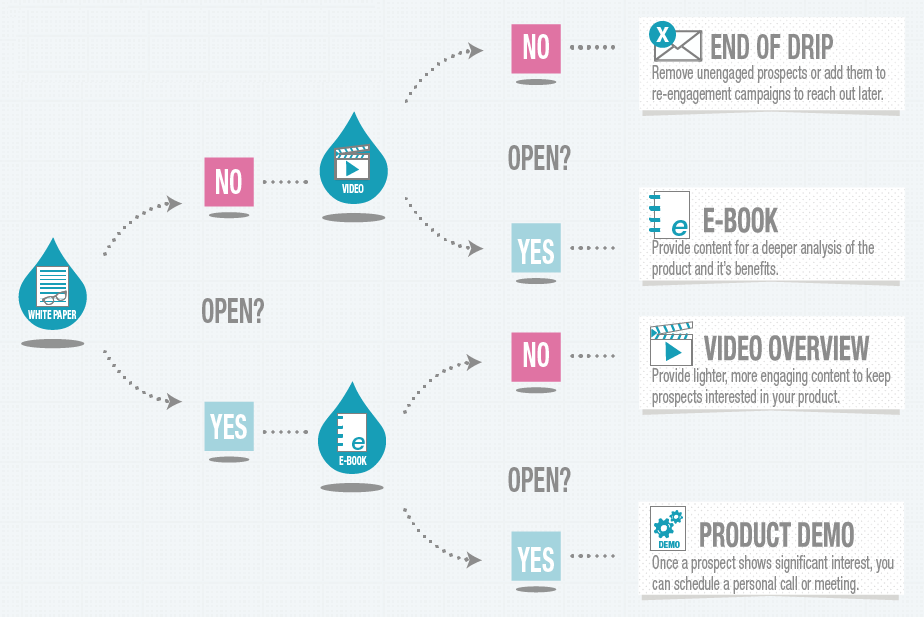Drip marketing campaigns are used to reach a very specific target audience and deliver a distinct marketing message. Used to increase customer awareness about a company’s products or services, drip marketing campaigns can be extremely effective when executed correctly.
What is drip marketing?
Drip marketing is based on an agricultural practice known as drip irrigation. In drip irrigation, crops are nurtured and grown using a perfectly measured amount of water delivered in “drips” over time.
Drip marketing is characterized by the idea of “dripping” relevant pieces of information to customers at the appropriate moments. Drips are often referred to as “touches,” and are scheduled moments when the business reaches out to the customer, usually through email or other online platforms.
Types of Drip Campaigns
Because each business, customer, and marketing initiative is different, there are different types of drip campaigns that a marketer can choose to employ.
The six types of drip marketing campaigns are listed below:
- Top-of-Mind Drips: Meant to engage your leads at critical points throughout the sales process.
- Educational Drips: Provides the target audience with relevant and helpful information, not a sales pitch.
- Re-engagement Drips: Used to connect with consumers who were interacting with your product, but then stopped.
For example, a customer who filled an eCommerce shopping cart, but then never checked out who received contact and ended up making the final purchase.
- Competitive Drips: To get your competitor’s customers to make the switch to your product or service.
- Promotional Drips: Aim to promote one of your products or services, usually offering a discounted price or limited time offer.
- Training Drips: Less common, but made to help guide readers through a training program, or explain information to new customers.
Each type of drip campaign is entirely dependent upon your business’s needs and goals, which can be conducted using email, direct mail, or via social media platforms.
Photo courtesy of Zapier
Principles for Highly Effective Drip Marketing Campaigns
In addition to understanding the different types of drip marketing campaigns and how they can benefit your business, it’s also important to understand the principles of how to make them highly effective.
The single most important aspect of a drip marketing campaign is to identify your target audience. The more specific the audience is, the more effective your campaign will be. If you’re not sure how to identify your target audience, consider using Customer Relationship Management (CRM) software to help you.
You can segment a target audience by things like geographic location, where a customer is in the buying cycle (ready to purchase, competitor’s customer, early exit at checkout), or any other demographics/behaviors relevant to your business.
The second part of developing a successful campaign is to create the right target message. Now that you’ve identified your target audience, it’s time to figure out what exactly you want to say to them.
During this stage, it’s important to identify which type of drip marketing campaign you’ll be conducting. If you’ve identified that your target audience is people who have made a purchase from your business within the past six months, your drip campaign will be educational in nature. The target message might be to provide information about a new product you’ll be released within three months time.
Once you’ve decided what your campaign message is, create the contents of your message. Depending on the distribution channel for your message (email vs. social media), the type of content might differ.
Regardless of the template you use, make sure to use graphics or images. Double check for proper grammar and spelling, and be engaging as well as relevant.
Finally, you should test, and retest to assess the effectiveness of the campaign. If the drip campaign wasn’t as effective as you’d hoped, document it, make changes to your strategy and try again.
Examples of Highly Effective Drip Marketing Campaigns
There are a variety of businesses out there using drip campaigns as a part of their marketing outreach – who hasn’t received a promotional email before? However, not all businesses use drip marketing effectively.
Here are a couple businesses that have:
Iron Tribe Fitness: Iron Tribe Fitness designed an educational drip marketing campaign that sent 11 emails to subscribed customers over a time period of 18 days. The emails included a very targeted message about why the email receivers were prime candidates for Iron Tribe Fitness products and services. As a result, Iron Tribe Fitness experienced an increase in membership growth (about half of the email receivers decided to become members).
Moz: Most people in the marketing world have heard of Moz, the SEO consulting company that has expanded to include a variety of online business marketing services. Moz has a great drip marketing campaigns – they even designed an automatic response tool to teach new users how to use all of their tools and services. The educational training emails resulted in a million dollar revenue drive over a four-month time period.
Who needs to use drip marketing?
All types of businesses can benefit from drip marketing. Those who particularly need it, though, are business-to-business (B2B) marketers and eCommerce companies. Maintaining relationships and contact with potential and current customers over time is extremely important. It can be one of the most efficient ways to remind clients and consumers that your business is still around, still ready to provide products and services and still committed to delivering the best customer service experience possible.
What’s the Difference Between Drip Marketing and Closed Loop Marketing?
The terms “drip marketing” and “closed loop marketing” are often confused. Closed loop marketing is the overall process of gathering consumer data from the sales team, and then implementing marketing strategies based on that data.